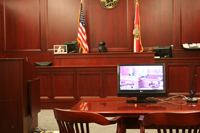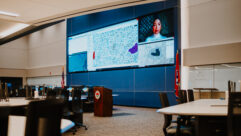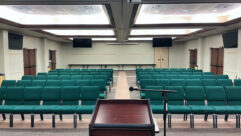

Clay County Courthouse, Green Cove Springs, Fla.
Jan 4, 2010 12:00 PM
Sophisticated PA and Recording System
Years ago, court reporting was limited to a stenographer while evidence was typically presented in a straightforward way, directly from the attorneys to the judge.
Of course, that’s changed. “The hardware for these systems now includes the most sophisticated audio and video reproduction systems available while evidence is brought in using cameras, computers, and videos from DVD recorders,” says Bob Ellis, a designer and integrator of courtroom AV systems for Veri-Core. “In terms of audio, there is a sophisticated PA system for the courthouse and the recording system to document the proceedings, which is critically important.”
Related Links

Conferencing is a very demanding environment for microphones, especially those held in large meeting spaces with high-level sound-reinforcement systems….

The Buzz: Installation Spotlight: Limestone County courthouse, Alabama
At Limestone County courthouse in Alabama, time is a valuable commodity. Located in the northernmost part of the state, the county only has a population of about 78,000…

Government Installation Issues
Installing AV and other media systems for government clients is a multidimensional proposition. The bureaucracy and procedural process can often be as…
With the AV system for the Clay County Courthouse in Florida, Ellis says, “Even though there is typically only one audio system, it actually functions as two separate systems. The recording system has to be extremely clear and pick up things you don’t want the PA system to pick up, so we do a lot of switching and routing so that certain signals don’t go to the PA system, but do go to a specific channel in the recording.”
“[The recording system has become] a powerful tool for all types of court reporting replacing the old tape recorders, but is significantly more advanced,” Ellis says. “The software allows us to put tags, notes for reference, on it. The recording can be done remotely, and the storage format allows many different people to use it. It is absolutely secure and can’t be changed because it is the official court record.
“Because we are both a hardware and software-based company, it’s important for us to determine the best combination of microphones, mixers, and related equipment to accomplish the task at hand.
“For this, and most other projects, we invariably choose Astatic microphones because of their exceptional sound quality, the ease of use due to their variable pattern design. The support from the company has been outstanding.”
Explaining how the mics work in more detail, Ellis says, “Astatic variable-pattern microphones allow us to adjust the polar patterns for the different areas in a courtroom, each of which has a different function.”

For this installation, Ellis used the Astatic GN10VP and GN15VP gooseneck condenser mics (10in. and 15in. lengths, respectively) and 202R mini-boundary microphones, each of which features a choice of omnidirectional, cardioid, hypercardioid, figure-eight, and any tight or wide polar pattern in between to specifically tailor the polar pattern for optimum performance in any situation.
“Typically, we do four-zone sound systems: The judge and witness, who are always just one person speaking from an area, is one zone. The jury is another zone; the attorney tables and podium out in the well, which can have many people speaking from it, is another zone; and the gallery for the public is the last zone.
“So if these microphones are being moved around between these zones, it’s important to be able to control the patterns. Before Astatic, that used to require having many microphones on hand, which is harder for us to deploy and service, and also tough for the client because they have to pay for the additional mics. Now, we have two or three basic mic types, and can easily adjust for wherever they’re going to go.”
Asked about the appearance of the microphones, Ellis says, “Courtroom aesthetics are important, even to the point where some architects emphasize form over function. We always look to make it as aesthetically pleasing as possible, integrating the technology into the courtroom as discreetly as possible. Now, you are going to see cameras, IR panels, microphones, and projection displays, and more. In terms of integrating our gear with the intent of the architect, Astatic microphones work because they’re a low-profile design and don’t stand out, but they do their job very well.”
Summing up about the rapidly expanding framework courtroom mics have to function in effectively, Ellis says, “They function three different ways in the courtroom: for live sound reproduction, the critical recording, and we also do a lot of teleconferencing, which is gaining popularity with courtrooms.
“I’ve come up with a concept of using shared resources where there’s a centralized codec allowing all video enabled courtrooms have the ability to route to them, which saves them money because they don’t have to buy a codec for each courtroom. The sound system has to handle the echo cancellation and assorted support that’s required for it. The microphones must be able to reject a lot of background noise because it’s being sent anywhere. So you can end up teleconferencing between courtrooms, courthouses, and any other location in the world, all of which the Astatic GNVP microphones do very well.”










